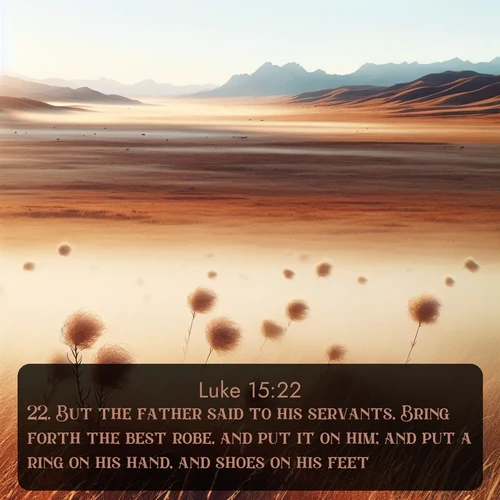The Parables - The Prodigal Son: A Father's Forgiveness
A parable about a father's unconditional love and the redemption of a repentant son. Luke 15:11-32 tells the story of a son who squanders his inheritance and returns home humbled.
The Parables - The Prodigal Son: A Father's Forgiveness
Luke
15:11-32/ KJV
11. And he said, A certain man had two sons:
12. And the younger of them said to his father, Father, give me the portion of goods that falleth to me. And he divided unto them his living.
13. And not many days after the younger son gathered all together, and took his journey into a far country, and there wasted his substance with riotous living.
14. And when he had spent all, there arose a mighty famine in that land; and he began to be in want.
15. And he went and joined himself to a citizen of that country; and he sent him into his fields to feed swine.
16. And he would fain have filled his belly with the husks that the swine did eat: and no man gave unto him.
17. And when he came to himself, he said, How many hired servants of my father's have bread enough and to spare, and I perish with hunger!
18. I will arise and go to my father, and will say unto him, Father, I have sinned against heaven, and before thee,
19. And am no more worthy to be called thy son: make me as one of thy hired servants.
20. And he arose, and came to his father. But when he was yet a great way off, his father saw him, and had compassion, and ran, and fell on his neck, and kissed him.
21. And the son said unto him, Father, I have sinned against heaven, and in thy sight, and am no more worthy to be called thy son.
22. But the father said to his servants, Bring forth the best robe, and put it on him; and put a ring on his hand, and shoes on his feet:
23. And bring hither the fatted calf, and kill it; and let us eat, and be merry:
24. For this my son was dead, and is alive again; he was lost, and is found. And they began to be merry.
25. Now his elder son was in the field: and as he came and drew nigh to the house, he heard musick and dancing.
26. And he called one of the servants, and asked what these things meant.
27. And he said unto him, Thy brother is come; and thy father hath killed the fatted calf, because he hath received him safe and sound.
28. And he was angry, and would not go in: therefore came his father out, and intreated him.
29. And he answering said to his father, Lo, these many years do I serve thee, neither transgressed I at any time thy commandment: and yet thou never gavest me a kid, that I might make merry with my friends:
30. But as soon as this thy son was come, which hath devoured thy living with harlots, thou hast killed for him the fatted calf.
31. And he said unto him, Son, thou art ever with me, and all that I have is thine.
32. It was meet that we should make merry, and be glad: for this thy brother was dead, and is alive again; and was lost, and is found.
Sermons Related to this Bible Chapter - The Parables - The Prodigal Son: A Father's Forgiveness
:General themes for this chapter of the Bible: The Lost Sheep; The Lost Coin; The Prodigal Son
Back to Index
























NOTE: The images reflect the following descriptions related to the theme : The Parables - The Prodigal Son: A Father's Forgiveness
- Macro closeup of a worn leather pouch, overflowing with scattered coins, representing the squandered inheritance. Dust motes dance in a single ray of sunlight piercing a darkened room.
- Macro closeup of a weathered, calloused hand reaching for a loaf of bread, depicting the son's hunger and desperation upon his return.
- Bright morning sunlight illuminates a field of ripe wheat, symbolizing the abundance the prodigal son left behind. A lone figure walks towards the horizon, symbolizing his journey home.
- Golden hour sunlight bathes a dusty road leading towards a distant village, depicting the journey of the prodigal son. A solitary donkey trails behind the walking figure.
- Evening twilight casts long shadows across a barren landscape, mirroring the son's despair before his return. Silhouetted against the setting sun, a lone figure sits dejectedly.
- The last rays of the setting sun paint the sky in hues of orange and purple, casting a warm glow on a simple farmhouse, a beacon of hope for the returning son.
- Morning light breaks over a bustling marketplace, filled with people going about their daily lives. A weary traveler stands apart, watching but not participating, symbolizing the son's isolation before his repentance.
- The sun rises, illuminating a group of farmers working in a field. One farmer stands alone, away from the others, his head bowed, a depiction of the son’s initial shame.
- Night falls on a village, the flickering lamplight casting shadows on the faces of the villagers. One solitary figure approaches the village gate, a sense of anticipation and trepidation in his posture.
- Darkness envelops a dimly lit stable, where a weary traveler rests amidst straw and animals. A single candle casts long, dancing shadows, symbolizing hope amidst despair.
- A richly detailed depiction of a father embracing his son, their faces etched with emotion, focusing on the texture of their clothing and the physicality of the embrace.
- A feast is prepared: a table laden with food, with emphasis on the textures of the fabrics and the details of the food, symbolizing the celebration of forgiveness. A father and son are seated, but only partially visible.
A link to this resource is much appreciated to let others know about this free christian resource. The AB Church in LAusanne-Renens is happy to make the image collection available for free.
The Prodigal Son in Art
The parable of the Prodigal Son has been a popular subject for artists throughout history. Here are a few notable paintings on this theme:
- "The Return of the Prodigal Son" by Rembrandt van Rijn (1606-1669, Netherlands)
Rembrandt depicted the emotional reunion of the father and son with great tenderness. He focused on the expressions and gestures of the figures, conveying forgiveness and love. Rembrandt was a master of light and shadow, and a key figure in the Dutch Golden Age. He was born in Leiden and died in Amsterdam.
- "The Prodigal Son" by Bartolomé Esteban Murillo (1617-1682, Spain)
Murillo's series of paintings on the Prodigal Son tells the story in a narrative sequence. His style is characterized by its realism and attention to detail. Murillo was a leading painter of the Spanish Baroque period, known for his religious scenes and genre paintings. He was born in Seville and died there.
- "The Prodigal Son" by Lucas Cranach the Elder (1472-1553, Germany)
Cranach's depiction of the parable often includes elements of landscape and genre scenes, reflecting the style of the German Renaissance. He was a court painter to the Electors of Saxony and a friend of Martin Luther. He was born in Kronach and died in Weimar.
Search for images of "Prodigal Son paintings" on Google: examples of Prodigal Son paintings
Related Theme
The Parable of the Lost Coin: A Woman's Joy





Related Pages: thematic Bible Images (French Version)

